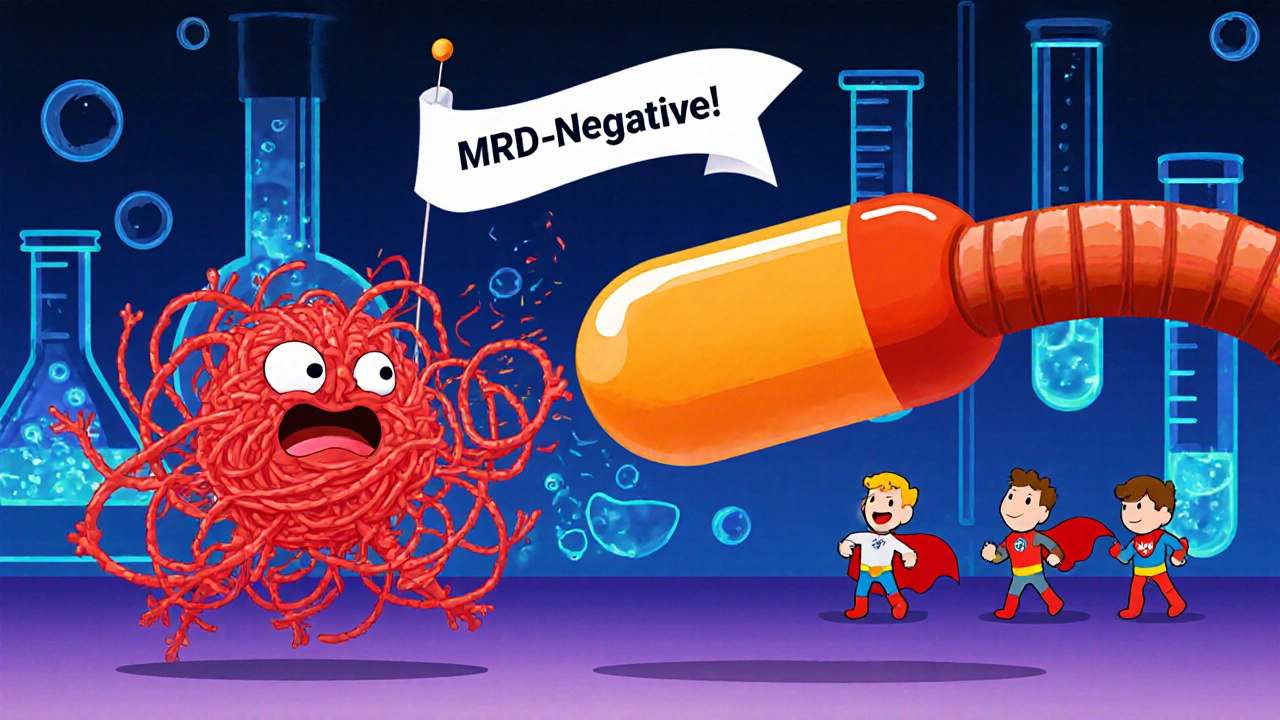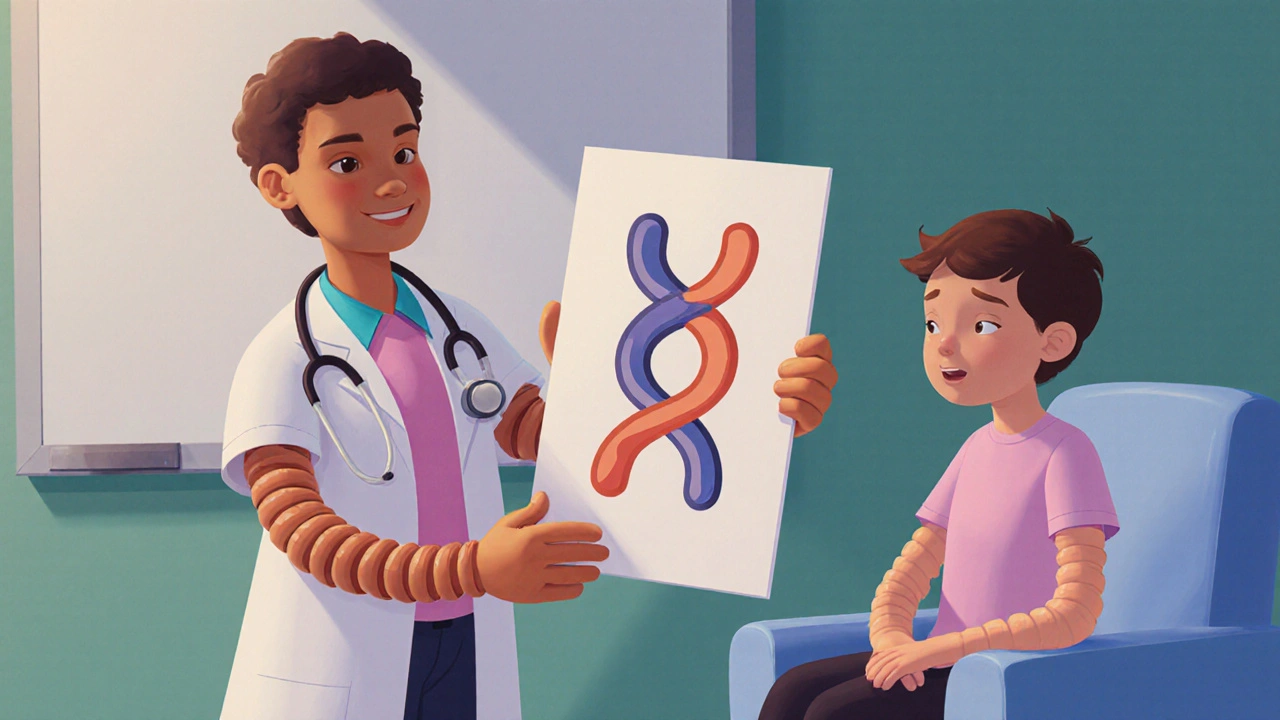When a doctor says Chromosome‑Positive Lymphoblastic Leukemia is the disease you or a loved one faces, the words can feel overwhelming. In short, it’s a fast‑growing form of acute lymphoblastic leukemia (ALL) that carries specific genetic changes - most often the Philadelphia chromosome or an MLL rearrangement. Those changes affect how the cancer cells behave and, crucially, which chemotherapy regimens work best.
Understanding the chemotherapy landscape helps you ask the right questions at the bedside. Chemotherapy is a group of medicines that kill rapidly dividing cells, and in ALL it’s delivered in phases: induction, consolidation, and maintenance. Each phase can be tweaked based on the chromosome abnormality, the patient’s age, and how well they tolerate the drugs.
Why Cytogenetics Matter
Two genetic players dominate chromosome‑positive ALL:
- Philadelphia chromosome - a translocation that creates the BCR‑ABL1 fusion gene, turning on a constant growth signal.
- MLL rearrangement - a break‑and‑join event involving the MLL (KMT2A) gene, common in infants and associated with aggressive disease.
Both drive the leukemia cells but respond to different drug combos. Knowing which one you have guides the choice between standard chemotherapy and targeted agents like tyrosine‑kinase inhibitors (TKIs).
Standard Induction Regimens
Induction aims to push the leukemic blast count down to undetectable levels. The classic “Hyper‑CVAD” protocol (cyclophosphamide, vincristine, doxorubicin, dexamethasone) is still used, often paired with:
- Asparaginase - starves leukemia cells that can’t make their own asparagine.
- Methotrexate - blocks DNA synthesis at high doses.
- Cytarabine - a nucleoside analogue that interferes with replication.
For Philadelphia‑positive cases, the backbone stays the same but a TKI (imatinib, dasatinib, or ponatinib) is added from day 1. This combo trims the disease faster and lowers the chance of relapse.
High‑Dose Consolidation & Re‑Induction
Once remission is achieved, the goal shifts to eradicating any hidden cells. High‑dose methotrexate and cytarabine are standard in consolidation, sometimes followed by a second round of induction if MRD (minimal residual disease) remains detectable.
Patients with MLL rearrangements often need intensified schedules because their disease hides well. Some centers use pediatric‑style protocols (e.g., “Berlin‑Frankfurt‑Münster”) even for adults, as they show better survival.
Maintenance Therapy: Keeping the Disease at Bay
Maintenance lasts 2-3 years and typically includes low‑dose oral methotrexate and 6‑mercaptopurine, plus periodic vincristine and prednisone pulses. The idea is to suppress any stray leukemia cells that survived earlier phases.
For Philadelphia‑positive patients, a low‑dose TKI is continued throughout maintenance, turning the treatment into a quasi‑chronic therapy that blocks BCR‑ABL1 signaling for the long haul.

Targeted and Emerging Options
Beyond TKIs, several newer agents are reshaping the treatment map:
- Blinatumomab - a bispecific T‑cell engager that links CD19 on leukemia cells to T‑cells, prompting an immune attack. Used often in relapsed or MRD‑positive disease.
- Inotuzumab ozogamicin - an antibody‑drug conjugate delivering a cytotoxic payload directly to CD22‑positive blasts.
- CAR‑T cell therapy - patient’s own T‑cells are engineered to target CD19, then reinfused. Currently approved for refractory B‑ALL and showing promise in chromosome‑positive subtypes.
These options often come after standard chemotherapy fails, but clinical trials are moving them earlier in the sequence, especially for high‑risk cytogenetics.
Choosing a Regimen: A Decision Tree
Below is a quick way to think about which chemo path fits a given patient:
| Chromosome Abnormality | Standard Regimen | Targeted Add‑on | When to Consider Advanced Therapy |
|---|---|---|---|
| Philadelphia chromosome (BCR‑ABL1) | Hyper‑CVAD + Asparaginase | Imatinib / Dasatinib (TKI) from day 1 | Persistent MRD after consolidation or relapse |
| MLL rearrangement | Pediatric‑style high‑intensity protocol | None specific yet | Early relapse or refractory disease |
| No detectable cytogenetic abnormality | Standard induction → consolidation → maintenance | Consider blinatumomab if MRD‑positive | Relapse after first remission |
Managing Side Effects
All chemo hits fast‑dividing cells, so you’ll likely see fatigue, nausea, and low blood counts. Specific drugs bring extra cautions:
- Asparaginase - watch for clotting problems and liver enzyme spikes.
- Vincristine - can cause peripheral neuropathy; dose reductions may be needed.
- TKIs - monitor heart function and watch for rash or GI upset.
Proactive support (anti‑emetics, growth factors, infection prophylaxis) keeps patients on track and reduces hospital stays.

Monitoring Response: The Role of MRD
Minimal residual disease testing, usually by flow cytometry or PCR, tells you if hidden cells linger after each phase. A negative MRD after induction is a strong predictor of long‑term survival, while a positive result often triggers a treatment intensification - possibly adding blinatumomab or moving to stem‑cell transplantation.
Future Directions
Research is leaning toward combining targeted agents with lower‑intensity chemo to cut toxicity. Early‑phase trials are testing next‑gen TKIs that overcome resistance, as well as bispecific antibodies that hit multiple leukemia markers at once.
Whole‑genome sequencing at diagnosis may soon let clinicians pick the optimal cocktail before the first dose, turning today’s “one‑size‑fits‑all” approach into a truly personalized plan.
Key Takeaways
- Chromosome‑positive ALL is driven mainly by the Philadelphia chromosome (BCR‑ABL1) or MLL rearrangements.
- Standard induction uses a mix of vincristine, steroids, anthracyclines, plus asparaginase, methotrexate, and cytarabine.
- Adding a TKI for BCR‑ABL1‑positive disease improves remission rates dramatically.
- MRD testing guides whether to stay on standard chemo or jump to newer agents like blinatumomab or CAR‑T.
- Future care will blend genetics, targeted drugs, and immune therapies for fewer side effects and better outcomes.
What is the difference between standard chemotherapy and targeted therapy for chromosome‑positive ALL?
Standard chemotherapy attacks all rapidly dividing cells, while targeted therapy (like TKIs) blocks the specific molecular driver - BCR‑ABL1 - that fuels the leukemia. Combining both gives a stronger attack with fewer relapses.
When is a stem‑cell transplant considered for these patients?
Transplant is usually offered if MRD stays positive after consolidation, if the disease relapses, or if a high‑risk cytogenetic like MLL rearrangement is present and the patient is fit enough for the procedure.
Can children with Philadelphia‑positive ALL receive the same chemotherapy as adults?
Yes, pediatric protocols are often adapted for children and actually show better survival than adult‑only regimens. They include the same TKI plus age‑adjusted doses of vincristine, steroids, and asparaginase.
What side effects should I watch for with asparaginase?
Look for swelling or pain in the abdomen, changes in blood clotting, and rising liver enzymes. If any appear, the doctor may pause or switch to a different formulation.
How often is MRD testing performed during treatment?
Typically after induction, after consolidation, and before maintenance. Some centers also test midway through maintenance if the patient had high‑risk features.
 Oct, 20 2025
Oct, 20 2025

Michael Kusold
October 20, 2025 AT 03:28hey folks, just read through the chemo options – pretty solid breakdown, though the jargon can get a bit dense for us laymen. the mix of standard drugs and the newer targeted stuff seems to be the way to go, especially when you got that Philadelphia chromosome lurking.
Jeremy Lysinger
October 20, 2025 AT 09:01Awesome summary! It really clears up why the TKIs are added right from day one – love the concise explain.
Nelson De Pena
October 20, 2025 AT 22:55Standard induction regimens such as Hyper‑CVAD remain the backbone of therapy for chromosome‑positive ALL, but the addition of targeted agents dramatically reshapes outcomes. For patients with the Philadelphia chromosome, incorporating a tyrosine‑kinase inhibitor from day one reduces leukemic burden more quickly and improves remission rates. The choice among imatinib, dasatinib, or ponatinib depends on mutation profile and patient tolerance. High‑dose methotrexate and cytarabine during consolidation aim to eradicate residual disease that survived induction. Monitoring minimal residual disease after each phase guides whether treatment intensification is necessary. In cases where MRD persists, clinicians frequently add blinatumomab or consider early stem‑cell transplantation. Pediatric‑style protocols, such as the Berlin‑Frankfurt‑Münster regimen, have been adapted for adult patients with MLL rearrangements, offering higher intensity without excessive toxicity. Asparaginase continues to be a critical component because leukemic cells cannot synthesize asparagine, yet its administration requires vigilant monitoring for hepatic and coagulation abnormalities. Vincristine, while effective, must be dosed carefully to avoid peripheral neuropathy, especially in older adults. Corticosteroids provide rapid cytoreduction but contribute to hyperglycemia and mood changes that need management. Emerging therapies like inotuzumab ozogamicin deliver cytotoxic payloads directly to CD22‑positive blasts, reducing off‑target effects. CAR‑T cell therapy targeting CD19 has shown remarkable remission durability in refractory disease, though cytokine release syndrome remains a concern. Ongoing trials are evaluating whether combining lower‑intensity chemotherapy with next‑generation TKIs can maintain efficacy while minimizing long‑term organ damage. Whole‑genome sequencing at diagnosis promises to personalize regimen selection before the first dose, moving beyond the one‑size‑fits‑all paradigm. Ultimately, the integration of cytogenetic data, MRD monitoring, and targeted agents creates a dynamic treatment algorithm that improves survival and quality of life for patients with chromosome‑positive ALL.
Wilson Roberto
October 21, 2025 AT 04:28Reading through the regimen details makes me reflect on the lived experience of patients – the relentless cycle of induction, consolidation, and maintenance can feel like an endless march. Yet, the hope embedded in targeted therapies offers a philosophical shift: instead of a blunt assault, we now see a tailored strike against the disease’s very DNA. This evolution underscores the importance of viewing each patient not merely as a case, but as a story where science and humanity intersect.
Narasimha Murthy
October 21, 2025 AT 18:21While the article extols the virtues of TKIs, one must consider the cost‑benefit ratio in real‑world settings. The incremental survival advantage may be offset by financial toxicity and the emergence of resistance mutations. Moreover, the data supporting early incorporation of blinatumomab remain limited to select trials, and broader applicability warrants skepticism.
Samantha Vondrum
October 21, 2025 AT 23:55Thank you for highlighting these nuances. It is crucial that patients and families receive clear, compassionate guidance when navigating such complex treatment landscapes. 🧡 Providing resources for financial counseling and support groups can help mitigate the burdens you mentioned, ensuring a more holistic approach to care.
Kelvin Egbuzie
October 22, 2025 AT 13:48Oh great, another round of "new drugs" that will probably be priced higher than my rent. As if the side‑effects weren’t enough, now we have to worry about insurance approvals and endless infusion appointments. 🙄
Katherine Collins
October 22, 2025 AT 16:35yeah same here lol 😅
Taylor Nation
October 23, 2025 AT 06:28These treatment updates clearly show the value of multidisciplinary collaboration. By integrating hematologists, pharmacists, and supportive care teams, we can tailor regimens to each patient's tolerance and optimize outcomes. Let’s keep the conversation focused on actionable steps for clinicians.
Nathan S. Han
October 23, 2025 AT 12:01Indeed! The drama of a well‑orchestrated regimen can feel like a symphony-each drug playing its part, crescendoing toward remission. When the patient finally achieves MRD‑negative status, it's a moment of triumph that reverberates through the entire care team.
Ed Mahoney
October 23, 2025 AT 17:35Sure, let’s just throw in another fancy drug and hope it works, because that’s how science always goes-more hype, less real data. :)